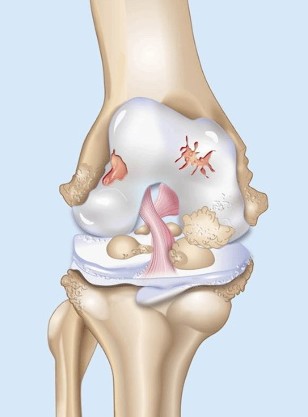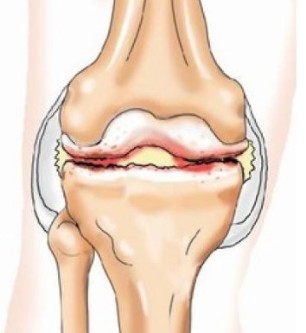Deforming gonarthrosis (knee osteoarthritis) is a disease in the hyaline knee cartilage inflammatory joint due to degenerated degenerative process. This disease does not cover condyle tibial and thighs.
Osteoarthritis of the knee joint develops slowly. The primary the signs of this disease are pain and stiffness of the movements. This variant of the oa, like the knee, is the most widespread in comparison with other species (osteoarthritis of the phalanges, osteoarthritis of the hip, elbow or shoulder osteoarthritis).
Manifest this disease is more often in people of middle age (40-45 years), mainly in women. The reason for the appearance of osteoarthritis in young people can be used of any serious injury or heavy load (e.g., in athletes).

The causes of osteoarthritis of the knee
The reason for the occurrence of osteoarthritis, the joints can not be alone, usually, it is the totality of the circumstances and of many catalytic factors that, over time, lead to the development of the disease. In medicine, the causes of osteoarthritis are divided into:
- primary;
- side.
Primary osteoarthritis develops in the elderly due to natural aging (erase) the cartilage tissues of the body in the together, with its complications. In a number of complications include such issues as:
- hereditary pathology;
- increasing the pressure on the joints in the course of life;
- obesity (in 10% of cases).
The secondary deformavit osteoarthritis include 30% of all cases of the disease in the knee iuncturam. This form of osteoarthritis develops because of various injuries:
- an injury to the meniscus;
- a fracture of the tibia;
- the rupture of the ligaments;
- high of the injury and the pain to the patella.
The symptoms of secondary osteoarthritis manifests itself much later, after 3-4 years, but when severe trauma signs of disease manifest themselves in 3-4 months.
In the risk group for the development of gonarthrosis includes persons who, after 40 years of age begin to participate in sports or other physical activities. Jogging, squats or chin-ups that give a extra work-worn age of the joints. These activities can lead to a rapid development in degenerative and degenerative process of the joints.
There are cases of development of osteoarthritis on the ground available in the patient co-morbidities:
- Ankylosing spondylitis;
- rheumatoid, psoriatic or reactive arthritis;
- gout;
- varicose veins;
- excess weight (obesity).
For reasons of development of arthrosis directly into the knee joint are:
- regular physical activity;
- lift weights;
- frequent elevations of the staircase;
- professionals during the year;
The risk of receiving such a diagnosis, such as the knee increases if the patient manifest trauma vertebral division of the bone, a variety of neurological diseases, metabolic disorders, diabetes, and the (3-5%) of the cases of genetic predisposition, due to the weakness of the ligamentous apparatus.
Often (50-60%) the development of osteoarthritis of the knee joint occurs due to a muscle spasm front of the thigh. This spasm does not occur before the onset of pain in the knees. The disadvantages are a low, low back pain, heavy legs and fatigue.
If ilio-lumbar and thigh muscle are constantly in a state of spasm, with the age in the patient developing a "facelift" of the knees, which would significantly reduce motor function.
The latest discovery of scientists
Belgian orthopaedic surgeons of the city of Leuven has recently discovered previously unknown and is not studied a bunch of ALL, which is localized in the knee. This link has been given the name of "anterior-lateral" or "anterolaterala".
The study, which lasted for more than 4 years, have been confirmed in rare cases, when patients after the success of the surgical intervention due to rupture of ligaments or knee injuries, physical pain does not disappear, and we have observed an instability of the knee joint.
Research have been attracted about 40 patients, which has allowed them to discover this keychain, about which the physicians had no data at all. As it turned out, the main function anterolaterala ligaments are a movement of rotation of the tibial bone.
When the damage to the tribe the doctors didn't know about the need to correct the situation during the surgery.
Classification crippling of osteoarthritis of the knee
Often, the disease develops in one knee. Given the intensity of the development of pathological processes, physicians distinguishes 3 degrees of the knee:
- The first degree of osteoarthritis of the knee does not deformavit of changes, but the characteristic of periodic pain after the stress on the joint. The ages manifesting slight swelling of the joint, the vanishing yourself.
- With osteoarthritis of the knee joint in the second degree of the symptomatology of the disease has dramatically increased. The pain syndrome occurs after a small physical activity. Walking, weight training, cause of long and intense sensations of pain, the patient has a characteristic knee crunch. Probably the aspect of slight deformation of the joint and a small limitation of movements.
- In the third degree osteoarthritis of the knee joint can produce maximum disclosure of the symptoms of the disease. The patient is disturbed of the approach, pronounced joint deformity and functional severe limits of detection of movements. The pain is exacerbated depending on the climatic conditions, the lack of articulation is a maximum of points. The pain is so severe that the patient could not find the position in which it has decreased, and sleep disorders.

With that may be confused with osteoarthritis of the knee joint?
There are several diseases similar symptoms with knee osteoarthritis:
The blockade of the knee joint, and the blockade of the meniscus. This disease develops quickly. The sudden movement produces a crackling sound in the knee with an acute attack of pain, which occurs in 10 to 15 minutes. A day later formed a swelling of the patella.
The different types of arthritis (rheumatoid, psoriatic, reactive), rheumatoid arthritis, Ankylosing spondylitis, gout. To distinguish this disease from osteoarthritis, you can using the analysis of blood.
The inflammation of the tendons of the knee. This disease mainly affects women after the age of 40. The pain occur when you lift weights or descending stairs. The pain covers the internal surface of the knee, but the functionality of the joint is not limited.
Vascular pain in the knee joints. It is a defeat of the joints, covering both knees at the same time. It mainly occurs among youth due to acceleration of bone growth. The pain syndrome is marked with:
- during a change in weather conditions;
- in case of common cold;
- during the fiscal year.
Defined as a throbbing pain (spin).
Symptoms crippling of osteoarthritis of the knee by steps
In the first phase of the affected area of the knee joint by appearances no different from healthy.
- Sometimes, in the neighborhood of the defeat, you may notice a swelling.
- In rare cases, iuncturam we observe the accumulation of fluid, and it is highly inflated, by taking spherical.
- Develops synovitis.
- Limited to the functionality of the joint.
- There is a sense of seriousness.
That this is due?
During the initial phase of development of osteoarthritis in the joint occurs a violation of the small-inside-blood vessels and circulation in general, which depends on the nutrition of the hyaline cartilage.
During the pursuit of the development of the disease (second stage), the symptoms increase. Pain is defined in the front-inside of the joint and of the mind not even large loads, receding in a state of rest, and back at the slightest movement.
Deforming osteoarthritis of the knee, the articulation of the third degree cruelly deformation joint of the bone. They fall into each other, the cartilage tissue is almost destroyed, restrictions, functional enhanced. Syndrome the pain does not recede, at any time, outside of the dependence of the voltage or a quiescent state in which is located the joint. Flexion and extension of the extremities difficult.
The joint severely deformed, legs deformed to o or X - shape, the approach is unstable. Very often, the patient needs to move around using crutches or a cane.
































